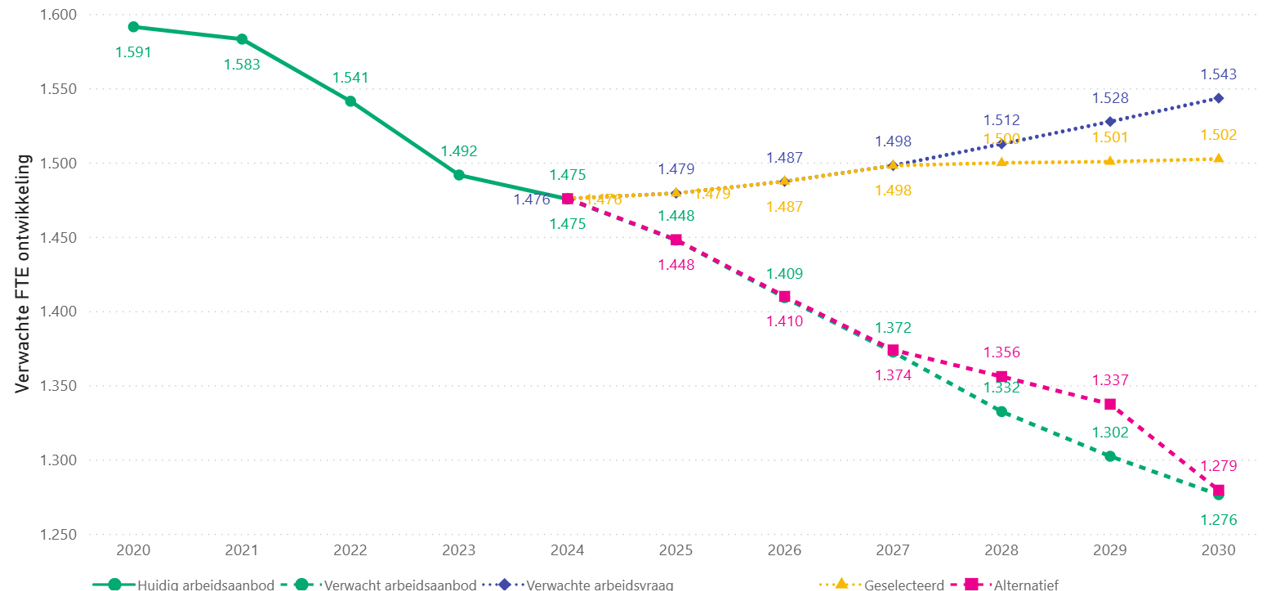
How can you close the care gap in your organisation?

Every care organisation faces the same challenge: how can we continue to deliver high-quality care in the future as the labour market grows ever tighter? PFZW Datadiensten offers employers a portal that allows them to view and analyse their own labour market data, complete with benchmarks. The latest addition to this portal is the SPP tool, a forecasting model that projects your organisation’s future workforce demand and supply.
From hindsight to foresight
At PFZW Datadiensten, we have long been committed to helping employers in the health and welfare sector gain deeper insight into their workforce data and labour market challenges. Through the HR Data Portal, we offer interactive dashboards that track developments in the workforce: inflow and outflow, age distribution, contract types, part-time factors and more. Employers can filter the data (for example, by role), analyse it, and benchmark their own figures against those of other organisations. The portal is widely and actively used, which prompted us to take the next step: looking ahead.
For any strategic discussion about the future of the organisation, it is essential to know not only where you stand today but also where you might be in five years’ time. What is on the horizon? How many staff will you have by then, and how many will you actually need? That is why we have expanded the HR Data Portal with the SPP tool – an instrument for strategic workforce planning.
Strategic workforce planning
The SPP tool enables you to assess, at organisational level, the expected future workforce demand and supply. Uniquely, it shows two projections: how your workforce is likely to develop if nothing changes, compared with how many people you will need to meet your organisation’s care demand in five years. Any gaps become immediately visible.
The demand forecast is based on care demand projections generated by the Prognosis Model for Health and Welfare, part of the AZW platform of the Ministry of Health, Welfare and Sport. In collaboration with the experts behind these projections, we have developed a way for organisations to model their own specific workforce demand. This makes the SPP tool unique: instead of general sector or regional forecasts, you receive a personalised calculation for your own organisation, which can be filtered by role.
Making the gap visible
What you often see is both striking and revealing. In many cases, the projected supply line declines, due to retirements and lower inflow than outflow. Meanwhile, the demand line rises or remains stable. The gap between the two? That is the challenge your organisation must address. And it is exactly here that the strategic conversation about urgency and possible courses of action begins.
The tool then allows you to model different scenarios by adjusting variables: what happens if you increase the average part-time factor? What if you invest in upskilling? How would your staffing be affected if employees worked longer, or if you redesigned certain types of care delivery?
Not just an HR tool, but an organisational tool
Although the term ‘strategic workforce planning’ may suggest otherwise, using the tool should ideally not be regarded as an exclusive HR responsibility. Because it is about the core of the organisation – delivering care – it should be approached from a multidisciplinary perspective. That means HR working together with care management, operations, finance and, ideally, with strong backing from the executive board. The tool provides a solid quantitative basis – not gut feeling or generic statements, but concrete figures: “In five years’ time we will have 840 FTE, but we will need 1,123.” This makes the strategic conversation more urgent and effective. And even if reality turns out differently, that does not diminish the tool’s value.
Guided implementation
The SPP tool is complex, just as strategic workforce planning itself is. That is why we never deliver it with only an instruction manual. We believe that would not reflect our role and responsibility to provide organisations with something genuinely valuable. At PFZW Datadiensten, we guide organisations through the process: we explain the tool, discuss the theory behind SPP, share examples, and support teams in building relevant scenarios tailored to their own context. We have developed a curriculum for this, combining theory, workshops and customised guidance. This ensures the tool is not used just once, but becomes a permanent part of cyclical SPP in the organisation.
Looking ahead
We do not see the SPP tool as a finished product, but as a starting point. Our aim is to help care organisations look further ahead and act more effectively. We will continue to develop the model, for example by adding more variables such as absence data or vitality indicators, potentially in collaboration with the specialists at PGGM&CO and Vernet – the other pillars of the Vitality in Health and Welfare initiative. Variables such as ‘reduced absenteeism’ or ‘improved vitality’ could provide valuable input for future scenarios. Our ambition is an integrated proposition: up-to-date and predictive data insights, analysis and scenarios for all HR-related themes, supporting both operational and strategic decisions.
Would you like to know more about the SPP tool or start using it yourself?
Contact PFZW Datadiensten at datadiensten@pfzw.nl or visit SPP-tool - Werkgevers | PFZW. We will be happy to explore what might be possible for your organisation.

Share or Print Article
click on the icon




